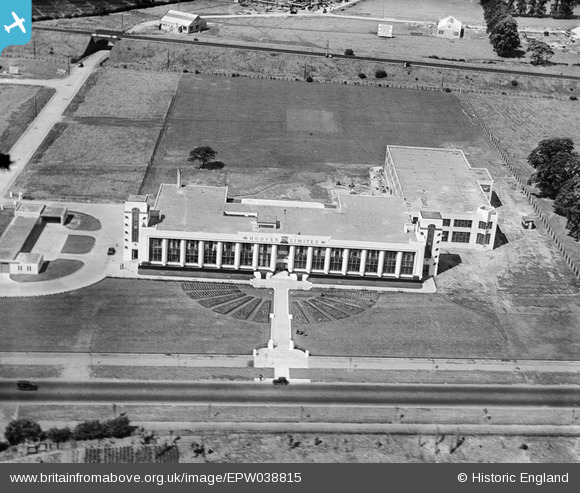EPW038815 ENGLAND (1932). The Hoover Factory, Perivale, 1932
© Copyright OpenStreetMap contributors and licensed by the OpenStreetMap Foundation. 2025. Cartography is licensed as CC BY-SA.
Nearby Images (24)
Details
| Title | [EPW038815] The Hoover Factory, Perivale, 1932 |
| Reference | EPW038815 |
| Date | June-1932 |
| Link | |
| Place name | PERIVALE |
| Parish | |
| District | |
| Country | ENGLAND |
| Easting / Northing | 516676, 182960 |
| Longitude / Latitude | -0.31766737035816, 51.532994721831 |
| National Grid Reference | TQ167830 |
Pins
Be the first to add a comment to this image!
User Comment Contributions
Built for The Hoover Company, the building originally housed Hoover's main UK manufacturing facility making vacuum cleaners, and employed up to 600 staff in the its offices and works. The original building (No. 1) was built in 1932 and contained the main offices; before it was completed plans were being put in place to add manufacturing facilities. As staff moved into their new offices foundations were being laid for a factory block to the east of the original building; this new block came to be known as Building No.3 and was complete and fully operational by February 1933. In January 1934 plans were drawn up for an additional two storey extension on top of the factory building and by May 1934 construction was well under way. Demand for Hoover vacuum cleaners continued to grow and in 1935 Wallis, Gilbert and Partners designed a new factory (Building No. 5) behind the original building. In 1938 a separate canteen and recreation centre (Building No. 7) was completed to the west of the original office. John Betjeman described it as, "a sort of Art Deco Wentworth Woodhouse - with whizzing window curves derived from Erich Mendelsohn's work in Germany, and splashes of primary colour from the Aztec and Mayan fashions at the 1925 Paris Exhibition."[1] With thanks to Wikipedia |
Allen T |
Thursday 16th of May 2013 01:17:41 PM |


![[EPW038815] The Hoover Factory, Perivale, 1932](http://britainfromabove.org.uk/sites/all/libraries/aerofilms-images/public/100x100/EPW/038/EPW038815.jpg)
![[EPW038721] The Hoover Factory, Perivale, 1932](http://britainfromabove.org.uk/sites/all/libraries/aerofilms-images/public/100x100/EPW/038/EPW038721.jpg)
![[EPW038816] The Hoover Factory, Perivale, 1932](http://britainfromabove.org.uk/sites/all/libraries/aerofilms-images/public/100x100/EPW/038/EPW038816.jpg)
![[EPW039558] The Hoover Factory, Perivale, 1932](http://britainfromabove.org.uk/sites/all/libraries/aerofilms-images/public/100x100/EPW/039/EPW039558.jpg)
![[EPW039555] The Hoover Factory and Sandersons Wallpaper Manufactory, Perivale, 1932](http://britainfromabove.org.uk/sites/all/libraries/aerofilms-images/public/100x100/EPW/039/EPW039555.jpg)
![[EPW038719] The Hoover Factory, Perivale, 1932](http://britainfromabove.org.uk/sites/all/libraries/aerofilms-images/public/100x100/EPW/038/EPW038719.jpg)
![[EPW039562] The Hoover Factory, Perivale, 1932](http://britainfromabove.org.uk/sites/all/libraries/aerofilms-images/public/100x100/EPW/039/EPW039562.jpg)
![[EPW039556] The Hoover Factory and Sandersons Wallpaper Manufactory, Perivale, 1932](http://britainfromabove.org.uk/sites/all/libraries/aerofilms-images/public/100x100/EPW/039/EPW039556.jpg)
![[EPW039561] The Hoover Factory and Sandersons Wallpaper Manufactory, Perivale, 1932](http://britainfromabove.org.uk/sites/all/libraries/aerofilms-images/public/100x100/EPW/039/EPW039561.jpg)
![[EPW039560] The Hoover Factory and Sandersons Wallpaper Manufactory, Perivale, 1932](http://britainfromabove.org.uk/sites/all/libraries/aerofilms-images/public/100x100/EPW/039/EPW039560.jpg)
![[EPW039557] The Hoover Factory and Sandersons Wallpaper Manufactory, Perivale, 1932](http://britainfromabove.org.uk/sites/all/libraries/aerofilms-images/public/100x100/EPW/039/EPW039557.jpg)
![[EPW039554] The Hoover Factory, Perivale, 1932](http://britainfromabove.org.uk/sites/all/libraries/aerofilms-images/public/100x100/EPW/039/EPW039554.jpg)
![[EPW039556A] The Hoover Factory and Sandersons Wallpaper Manufactory, Perivale, 1932](http://britainfromabove.org.uk/sites/all/libraries/aerofilms-images/public/100x100/EPW/039/EPW039556A.jpg)
![[EPW039559] The Hoover Factory, Perivale, 1932](http://britainfromabove.org.uk/sites/all/libraries/aerofilms-images/public/100x100/EPW/039/EPW039559.jpg)
![[EPW039563] The Hoover Factory, Perivale, 1932](http://britainfromabove.org.uk/sites/all/libraries/aerofilms-images/public/100x100/EPW/039/EPW039563.jpg)
![[EPW040870] Housing developement around the Hoover Factory, Perivale, from the south-west, 1933](http://britainfromabove.org.uk/sites/all/libraries/aerofilms-images/public/100x100/EPW/040/EPW040870.jpg)
![[EPW040869] Housing developement around the Hoover Factory, Perivale, from the south-west, 1933](http://britainfromabove.org.uk/sites/all/libraries/aerofilms-images/public/100x100/EPW/040/EPW040869.jpg)
![[EPW043714] A new housing estate off Bilton Road, Perivale, from the south-west, 1934](http://britainfromabove.org.uk/sites/all/libraries/aerofilms-images/public/100x100/EPW/043/EPW043714.jpg)
![[EPW040868] Housing developement around the Hoover Factory, Perivale, from the south-west, 1933](http://britainfromabove.org.uk/sites/all/libraries/aerofilms-images/public/100x100/EPW/040/EPW040868.jpg)
![[EPW043712] A new housing estate off Bilton Road, Perivale, from the south-west, 1934](http://britainfromabove.org.uk/sites/all/libraries/aerofilms-images/public/100x100/EPW/043/EPW043712.jpg)
![[EPW043715] A new housing estate off Bilton Road, Perivale, from the south-west, 1934](http://britainfromabove.org.uk/sites/all/libraries/aerofilms-images/public/100x100/EPW/043/EPW043715.jpg)
![[EPW035540] The Sanderson and Sons Wallpaper Manufactory and surrounding countryside, Perivale, from the south-west, 1931](http://britainfromabove.org.uk/sites/all/libraries/aerofilms-images/public/100x100/EPW/035/EPW035540.jpg)
![[EPW038720] Construction of houses at Dawlish Avenue and the Hoover Factory, Perivale, 1932](http://britainfromabove.org.uk/sites/all/libraries/aerofilms-images/public/100x100/EPW/038/EPW038720.jpg)
![[EPW053243] Factories around Wadworth Road and Western Avenue, Perivale, 1937. This image has been produced from a damaged negative.](http://britainfromabove.org.uk/sites/all/libraries/aerofilms-images/public/100x100/EPW/053/EPW053243.jpg)